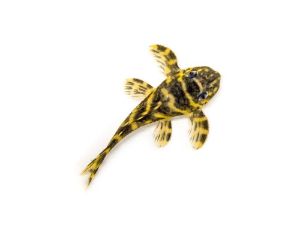
L340 Mega Clown AKA Imperial Tiger Pleco (Hypancistrus sp.)

The Imperial Tiger Pleco (Hypancistrus sp.), also known as the L340 Mega Clown Pleco, is a species of suckermouth catfish native to South America. The maze-like yellow and black stripes on its body and its relatively social nature make this fish an exceptional addition to any planted or micro aquarium. We're pleased to announce that we now have juvenile, wild-caught Mega Clown Plecos available in our fish tank! While captive-bred animals tend to have a higher average age, wild-caught ones tend to be cheaper because they are older. Also, wild-caught animals typically have lower health, making it more challenging for them to adapt to an aquarium environment.
Since Mega Clown Plecos are generally docile and hardy, they make a great addition to aquariums of all sizes. The Mega Clown Pleco only grows to a height of 3.1 inches (8.2 cm), in contrast to the Common Pleco (Hypostomus plecostomus) and Trinidad Pleco (Hypostomus punctatus), which can be seen in many locations and reach a whopping 18 to 20 inches (45 to 51 cm) in length (8 cm). This smaller pleco is much easier to care for, and it can do well in an aquarium as small as 30 gallons. Although male plecos have a reputation for being territorial, most disputes can be avoided by providing ample space and hiding areas for all fish. While the Mega Clown Pleco typically pays no attention to the other tank mates, it is possible that the small shrimp fry could fall prey to its antics. One interesting fact is that some commercial shrimp farms raise Mega Clown Plecos in the same pools they use for shrimp.
The Mega Clown Pleco is primarily a nocturnal fish, so it is best to provide it with plenty of hiding places during its initial adjustment to its new aquarium, such as driftwood, rocks, and other objects. It is not known to eat as much wood as other plecos (Panaque speciosum, etc.), but occasional supplementation with wood may be beneficial (or bio-film on driftwood). Most plants will not be disturbed by the Mega Clown Pleco, and it is not an effective algae eater. If you want to keep your Mega Clown Pleco in good health, you should provide it with meaty, insect larvae feeds like Bloodworms (https://guppiesforsale.net/index.php/pages/Hikari-Bio-Pure-Freeze-Dried-Bloodworms-Ingredient.html), Tubifex, Daphnia, etc. The fresh vegetables shelled peas, spinach, zucchini, and cucumber are all good options. Dry foods containing animal and plant components, such as algae wafers, should not make up the bulk of the Mega Clown Pleco's diet.


$40.00
References
Albino Bushy Nose Pleco (Ancistrus sp.) is a member of the Loricariidae family of South American suckermouth catfishesAsian Stone Mini Catfish (Hara jerdoni) Their small size makes them perfect for small tanks - they only grow to a maximum of 1 1/2 inches in length
Banjo Catfish (Bunocephalus coracoideus) this catfish is popular because of its strange appearance
Bristlenose Pleco (Ancistrus sp.) is a member of the Loricariidae family of South American suckermouth catfishes
Corydoras sterbai (Sterba's Corydoras) are among the most popular of the numerous currently known species within the Corydora classification
L134 Leopard Frog the Imperial Tiger Pleco (Peckoltia compta) is a member of the Loricariidae family of South American suckermouth
L201 Snowball Pleco (Hypancistrus inspector) also known as the Orinoco Angel Pleco, is a member of the Loricariidae family of South American suckermouth catfishes
L333 King Tiger Pleco (Hypancistrus sp.) is primarily nocturnal, but will often become active during daytime hours once established in an aquarium with plenty of driftwood, rockwork
L340 Mega Clown AKA Imperial Tiger Pleco (Hypancistrus sp.)
Otocinclus Catfish known as Otto Cats, otos, or dwarf suckermouth catfish
Panda Cory Catfish (Corydoras panda) is a very animated, distinctively marked schooling fish that is perfect for the community and planted aquarium
Rio Ucayali Bristlenose Pleco is a member of the Loricariidae family of South American suckermouth catfishes. While many suckermouth catfish species have yet to be bred commercially in aquariums, the very rare Orange Spot Bristlenose Pleco is now available




